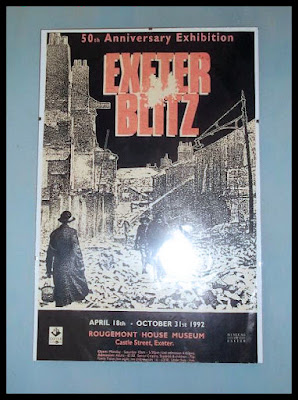Situated just outside and to the left of the castle gate is this rather grand yet pleasing Grade II* Listed building, which was built circa 1768 by John Patch, a local surgeon. The front elevation faces north-west and consists of two segmented bows, each containing three long windows, and a balcony above with iron balustrade and canopy.
The entrance, below, includes a Tuscan porch, above which is a small arched window, which is rather attractive. Further above that is a roundel window.
I don't have a photo of the south-east side but it consists of two angle bows, one of which you can see on the left corner in these photos above and below. This one consists of blind windows, either as a decorative feature to balance the look or because the former windows were blocked up.
I
do have this one below, which is of the rear to Rougemont House. It
looks as though as extension was made. However, the windows look
commensurate with the style of the time therefore may have been built
then. It also wouldn't be necessary for the plain walls to be rendered
where it sits snugly within a corner of the city wall.
Rougemont
House was bought by the Council in 1911 and became
part of the Royal Albert Memorial Museum, mainly for a permanent
display of costumes but also for special exhibitions. In 1992 there was an exhibition for the 50th anniversary of the Exeter Blitz. It was fabulous
and I still have the poster I bought hung up in my kitchen. A quick digi photo of the poster below.
Sadly, the museum is now closed and the house is now a hotel.
However, John Patch also began to landscape the gardens, which was continued by his successors. These are also listed, in the National Register of Historic Parks and Gardens, and are Grade II.
The landscaping is shaped by a defensive ringwork included during William the Conqueror's plans for Rougemont Castle after the Norman Conquest in 1068. It's also thought that because of the depth it may have been used as a stone quarry by the Romans for building the original castle walls.
The gardens were also bought by Exeter City Council the year after the house in 1912. Maintained as a public park, the whole of these and the adjoining Northernhay Gardens (along with the city walls) surround the castle walls, gatehouse and Athelstan's Tower. They are all scheduled as an archaeological site of national importance.
At the time of the black & white photos above, taken in 1991, people enjoyed the gardens as a place to walk around, hang out with friends or for lunchbreaks, etc. I don't know how they are now but the last time I went a few years ago it didn't feel as safe and I quickly exited without taking many photos. The one below is the only one that came out okay.
And a final photo from 1991.
As I said at the end of the previous post, I wasn't going to write this article up until I had more photos. Unfortunately, due to worsening back and joint injuries I can't see myself getting there for the forseeable future. However, on a happier note I've actually been feeling a lot better in the last few of days - finally! lol - but I'm still taking things very slowly for now until I get stronger.
If and when I do I'll be sure to add more photos to this post or create a new one. There's such a lot of information too, so maybe this one can be a taster for a fuller article also including the adjoining Northernhay Gardens. We'll see how it goes.
Cheers. :)















No comments:
Post a Comment